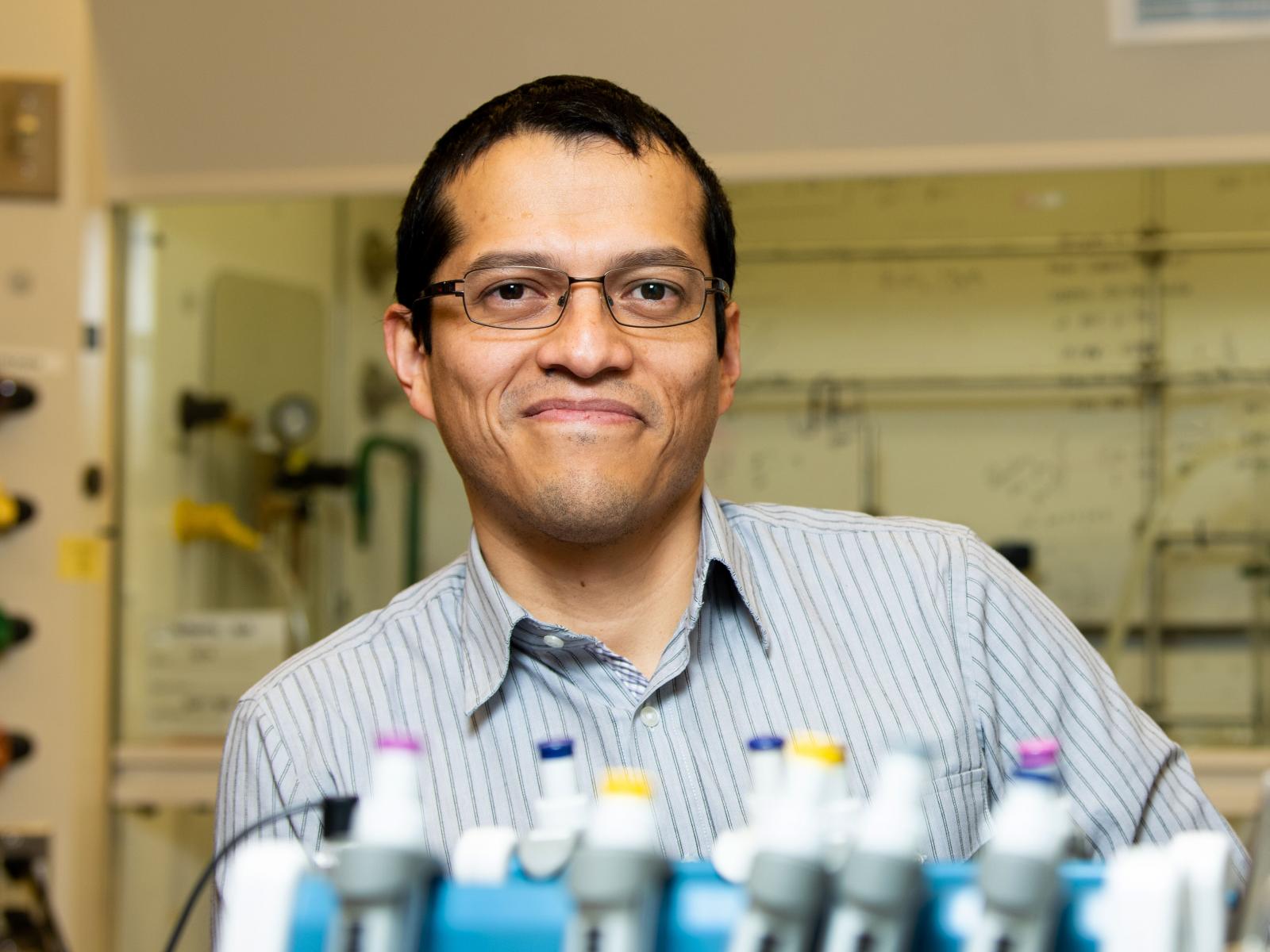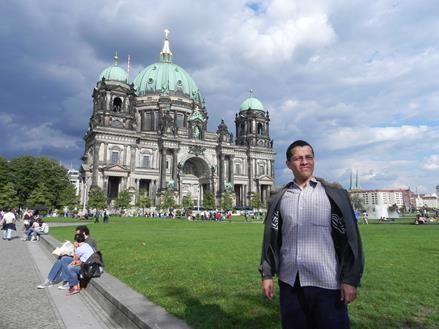Oliver Gutiérrez Takes on a ‘Multidimensional Challenge’
In search of efficient biofuels, a PNNL researcher investigates the catalytic electrolyte-to-electrode interface in aqueous media

Chemical engineer Oliver Y. Gutiérrez poses in a laboratory in the Physical Sciences Laboratory building.
Photo by Andrea Starr | PNNL
Oliver Y. Gutiérrez, a chemical engineer at Pacific Northwest National Laboratory (PNNL), is part of a multidisciplinary team within PNNL’s Institute for Integrated Catalysis (IIC).
The Chemical Transformations Initiative (CTI) is developing efficient catalysts and catalytic processes for converting renewable stores of carbon, processed under mild conditions (low pressures and near-ambient temperatures), to make chemicals and energy-dense liquid fuels.
Carbon is stored in the oceans, atmosphere, and soils. Aboveground, it is present in plant-based biomass―vast but hard-to-extract reservoirs of carbon-rich chemical compounds that include crop waste, forest biomass, purpose-grown crops, manure, and even algae.
Gutiérrez leads CTI’s electrocatalytic hydrogenation research team. Its four members look at new-generation catalysts at the molecular level and in an aqueous state. (Traditionally, most catalysts are deployed in an organic or gas-phase process.)
“We focus on the aqueous phase because of the nature of many carbon sources within biorefineries: They have water in them,” he says. “Yet in terms of fundamental chemistry, we don’t know how things happen in water. That’s the main challenge.”
‘Dimensions of complexity’
Gutiérrez and his team also investigate electrical potential as an energy source for fuel conversion.
Electrocatalysis derives energy from electrolyte-to-electrode interfaces, which means you don’t have to burn something to get energy. In fact, CTI is looking at ways to power chemical reactions with renewable sources like wind and solar.
In 2018, Gutiérrez was the corresponding author on a key paper from the CTI effort that showed how electrochemistry has some advantages over normal catalysis. The paper’s senior author was PNNL physical chemist and ICC Director Johannes Lercher.
For one, electrocatalysis does not require increasing process temperatures or adding hydrogen, which traditional catalysis does.
On the other hand, concedes Gutiérrez, traditional catalysis “is probably easier to understand chemically. “You have a metal and you heat it up.”
Electrocatalysis is also challenging because its little-known aqueous catalytic environment adds “dimensions of complexity,” he says, and it requires developing novel materials. “We connect electrodes to a metal―and the nature of that metal is something we study.”
Diversifying sources of carbon

CTI’s work is to look for the ideal inorganic catalysts that can convert biomass waste into useful fuels.
“Nature knows how to do the kind of catalysis that converts carbon from biomass,” says Gutiérrez, “but very slowly.”
With millions of years to perfect processes in nature, catalytic proteins called enzymes require lower temperatures and pressures than most modern catalysts.
At CTI, says Gutiérrez, “the goal is to convert carbon from a waste source into fuel, but at a higher rate than nature can do it.”
That requires developing catalytic technologies for fuels beyond coal, natural gas, and petroleum. CTI is focused on finding catalytic processes that recover carbon from aboveground terrestrial biomass and waste feedstocks.
“At one point, we have to diversify sources of carbon,” says Gutiérrez. “It would be great to find the ‘new petroleum,’ but there is no commercial process that can compete with oil.”
‘A multidimensional challenge’
The upside of making fuels from renewable resources such as crop waste is that “we will not have to change our transportation technology,” says Gutiérrez. The fuels, in manageable liquid and gas forms, will work in present-day pumps and distribution pipelines.
The downside is that stores of terrestrial sequestered carbon are “recalcitrant”: that is, hard to extract. Such waste sources are also dirty, wet, expensive to convert (so far), and sometimes available only seasonally
“It’s a multidimensional challenge to make the renewables process efficient enough. It’s not just a chemical challenge.” ― Oliver Y. Gutiérrez
To make matters worse, naturally occurring poisons in feedstocks can degrade or kill candidate catalysts.
The carbon in these terrestrial natural resources is present only in low concentrations. Petroleum, by contrast, even in its crudest form, is energy-dense at the wellhead.
“It’s a multidimensional challenge to make the renewables process efficient enough,” says Gutiérrez. “It’s not just a chemical challenge.”
That’s why CTI includes not only chemists and engineers, but also economists trained to outline cost-benefit scenarios.
Another challenge is that conversion facilities will have to be small, local, and modular―portable reactors that move from place to place depending on the location of the feedstocks. By contrast, petroleum refineries are as big as cities, centralized, and have well known cost returns.
'The best you can'

Gutiérrez―now the father of three―now the father of three―grew up the northeast edge of Mexico City. The 1 million-plus residents of his native Netzahualcoyotl (“a city within a city,” he says) were then among the region’s poorest.
The son of a grocer, he was the oldest of three sons, all college-educated now. Gutiérrez fell in love with chemistry early, was smitten with the engineering side of it, and took opportunities as they came along.
University was “almost free,” he says. “What you pay is largely symbolic.”
Being a postdoc in Germany “was an opportunity too, and I took it,” says Gutiérrez. “PNNL was an opportunity and I took it.”
Still, before opportunity, there was family.
“My family inspired me not in the sense of going into science,” he says, “but in doing the best you can and working as hard as you can.”
A bridge to PNNL
Gutiérrez attended the Universidad Nacional Autonoma de Mexico (National University of Mexico) in Mexico City (M. Eng. 2005, PhD, 2009). He wrote his doctoral dissertation under the supervision of catalysis expert Tatiana Klimova on catalytic materials for petroleum processing that remove sulfur from oil streams.
“My family inspired me not in the sense of going into science, but in doing the best you can and working as hard as you can.” - Oliver Y. Gutiérrez
After the PhD, Gutiérrez won a two-year Alexander von Humboldt fellowship at the Technical University of Munich and ended up staying from 2009 to 2016.
In Germany, he led a research group on industrial catalysis, where he accepted a pair of challenges: to investigate both electrocatalysis and photocatalysis (how chemical reactions are speeded up by light).
The former “built the bridge to PNNL,” says Gutiérrez, by way of a joint project that was “strongly identified with CTI.”
In 2017, he arrived at PNNL as a research scientist.
Since then, his team has been researching electrocatalysts “from the molecular scale on up,” says Gutiérrez, in order “to understand at a molecular level the chemistry that lies at the heart of this process.”